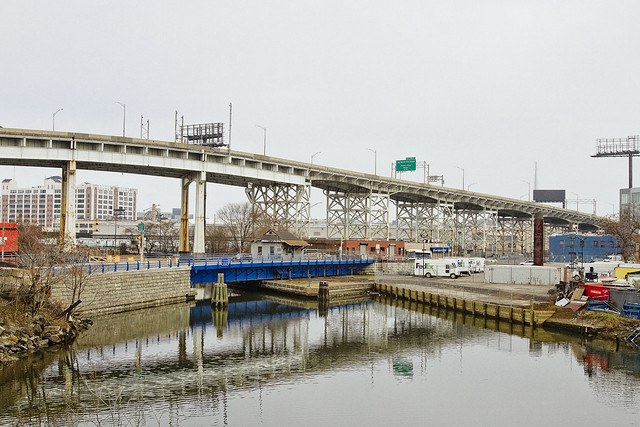modern matters
It’s Street Children’s Day, in the Republic of Austria.
– photo by Mitch Waxman
Dutch Kills, a tributary of Newtown Creek which abruptly turns north off the main channel three quarters of a mile east of the East River, is entirely contained within Long Island City. It’s crossed by five bridges – the LIRR bridges DB Cabin and Cabin M, the Borden Avenue Bridge, the Queens Midtown Expressway truss, and the Hunters Point Avenue Bridge. Dutch Kills, like all of Newtown Creek’s tributaries and the main channel itself, is lined with a toxic sediment referred to as “Black Mayonnaise.” This sediment is composed of coal tar, petroleum and refining byproducts, industrial waste of various provence and typology, as well as human excrement deposited by NYC’s open sewers.
At its northern terminus, Dutch Kills is across the street from a CUNY college and several charter schools serving high school and junior high school aged kids. One of the most significant build outs in recent real estate history is happening less than a quarter mile from that spot, along LIC’s Jackson Avenue in an area referred to as “Court Square.”
– photo by Mitch Waxman
Due to a non functioning railroad swing bridge at Dutch Kill’s junction with Newtown Creek’s main channel, there is absolutely zero maritime industrial activity along the tributary. The bulkheads along its reach generally date back about a century, to a massive “improvement” conducted around the time of the First World War which saw the marshes and swamps it fed drained and both the Sunnyside Yards and the Degnon Industrial Terminal constructed.
– photo by Mitch Waxman
The streets surrounding Dutch Kills offer fleeting glimpses of the waterway, and many of them are not City streets at all but “railroad access roads” owned by the MTA. You can almost always smell the waterway before you can see it, and whereas I can tell you a few spots to access the water, none of these are “legal” and all involve trespass of private or government property. You can legally observe it from the Borden Avenue or Hunters Point Avenue bridges, however.
At it’s terminus – or “turning basin,” there are two abandoned oil barges rusting and rotting away into the water.
– photo by Mitch Waxman
Illegal dumping, the native art form of the Borough of Queens, is practiced hereabouts with relish and abandon. The DSNY garbage bin in the shot above appeared on 29th street back in November, and I’ve been watching it steadily fill up and overflow. DSNY doesn’t seem to remember where they put it, as I haven’t seen it empty since the day it arrived.
– photo by Mitch Waxman
Amidst the sheens of oil and grease you’ll observe on Dutch Kills, which are both historic and newly spawned, there are what the NYC DEP would describe as “floatables.” That’s government code for garbage that’s either been flushed or has been swept into the sewer grates on every street corner in NYC. In the case of Dutch Kills, the “sewer shed” that feeds these floatables into it extends all the way to East Elmhurst and Woodside to the east, Sunnyside and Astoria to the north, and the rapidly growing Long Island City which Dutch Kills is a part of.
The sewer plant that handles this burgeoning area was opened in 1931, and Fiorello LaGuardia cut the ribbon to open it.
– photo by Mitch Waxman
There is going to be a meeting tomorrow, the latest of many, of the Newtown Creek Community Advisory Group (CAG) on the first of February. If the shot above looks good to you, and you’d like to see more of the same – don’t come. If you care about not having a billion and a half gallons of raw sewage a year spilling onto mounds of poisonous and century old industrial waste, do come. Pipe up, we need voices and perspectives from outside the echo chamber.
Details on the meeting – time, place, etc. – can be accessed at this link. We could really use some Queensican bodies and voices in the room.
– photo by Mitch Waxman
As evinced by the corpse pictured above, life has actually begun to recolonize this waterway in recent years. The presence of higher mammals hereabouts speaks to an ecosystem that is beginning to recover from centuries of industrial and municipal abuse. Of course, nothing is going to save a raccoon from getting ground into hamburger by the wheels of a semi truck.
At Newtown Creek Alliance, we’ve been cataloging and observing for a while now. There’s more than seventy individual species of birds for instance – including Great Blue Herons and Ospreys – living along the lugubrious Newtown Creek. Their presence speaks to a growing population of prey animals (fish) present in the water column, and to a broader environmental recovery happening along this industrial waterway at the literal center of NYC.
“follow” me on Twitter- @newtownpentacle












Good on you for championing the restoration of this long neglected area. I only hope that such a restoration, if it were to happen, does not presage more water-front development. The key is to maintain the area is a green/grey space, so as to keep the RESF from swarming. Sadly, sometimes neglect is all that protects these urban wildernesses from such man-made predations.
Tom
February 2, 2017 at 10:44 am